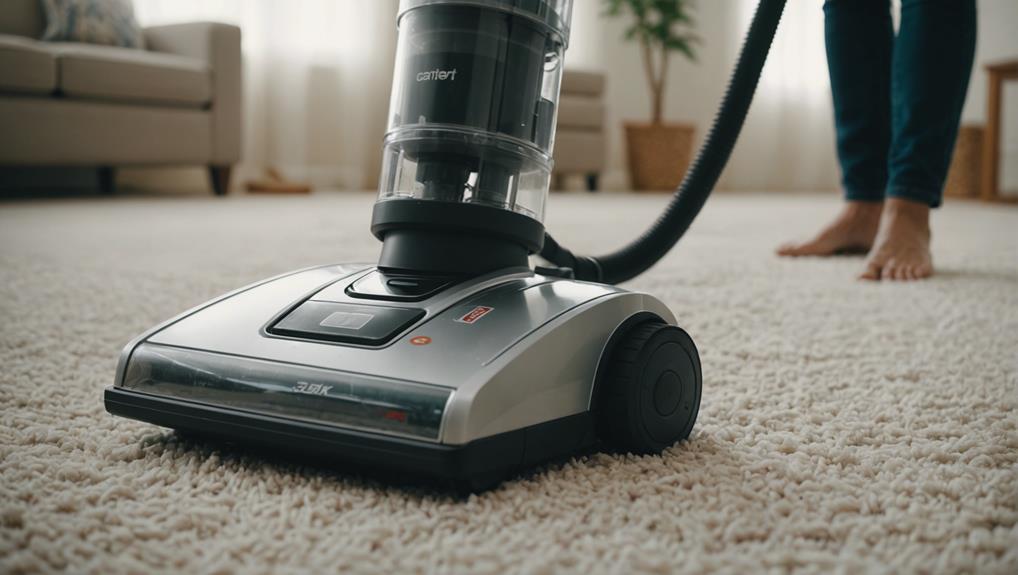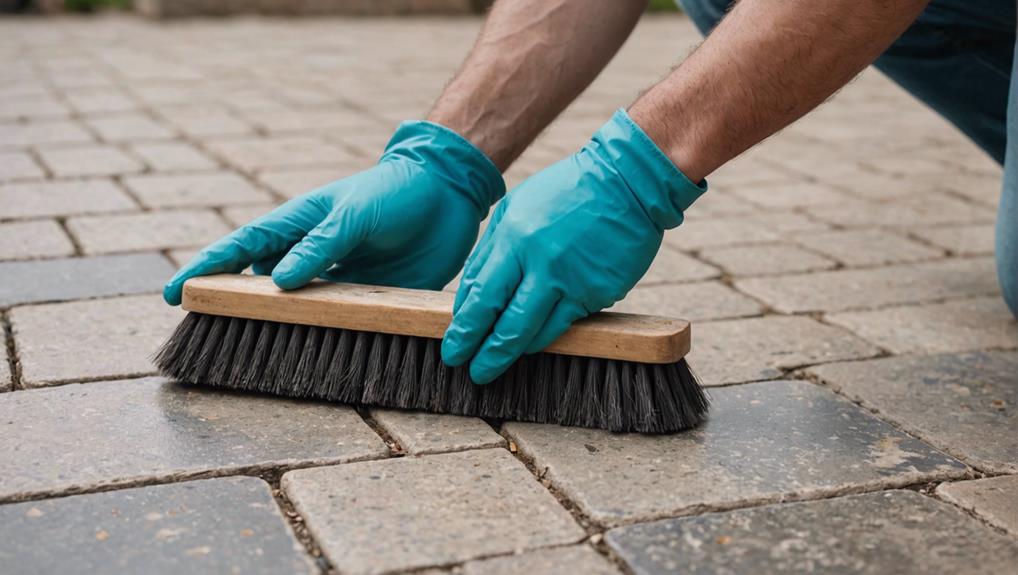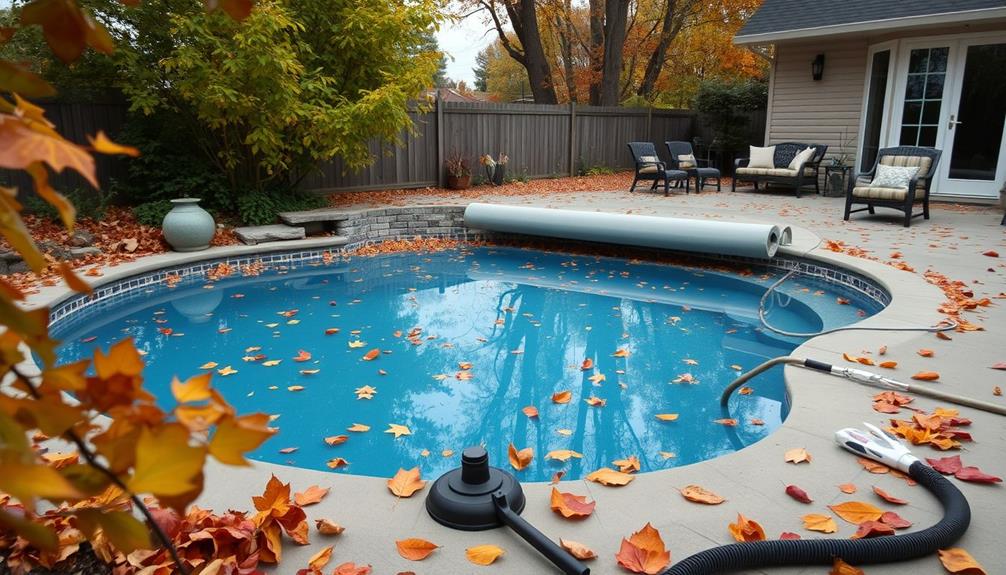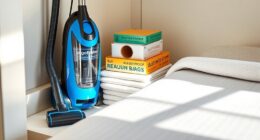To properly clean your carpet, it is crucial to maintain it regularly. Vacuuming high-traffic areas twice a week helps prevent dirt from building up. Using walk-off mats can reduce the amount of dirt that gets tracked in. It is important to promptly clean up spills to prevent stains from becoming permanent. Rotating furniture from time to time can help avoid wear patterns. For stain removal, consider using natural solutions like vinegar and baking soda. Getting your carpet professionally cleaned every 12-18 months ensures a thorough deep cleaning. Steam cleaning with high temperatures is effective in killing bacteria. Deep cleaning should be incorporated into your regular maintenance routine. By following these steps, you can keep your carpet clean and long-lasting. Further insights are available as you delve deeper into this topic.
Key Takeaways
- Regular vacuuming and spot cleaning prevent dirt buildup and stains.
- Use natural cleaning solutions like vinegar and baking soda for eco-friendly cleaning.
- Rotate furniture and use walk-off mats to reduce wear and dirt accumulation.
- Schedule professional steam cleaning every 12-18 months for deep sanitization.
- Promptly treat spills to prevent them from setting and causing permanent stains.
Importance of Regular Carpet Cleaning
Regular carpet cleaning is vital for maintaining a healthy indoor environment and extending the lifespan of your carpet. Clean carpets not only look better but also contribute to better indoor air quality by removing dirt, allergens, and debris that can accumulate over time.
Routine cleaning is essential to prevent embedded debris from causing wear and tear on your carpet, ultimately helping to prolong its life. By deep cleaning your carpets regularly, you can guarantee that your living space remains free from harmful particles that could impact your health.
Professional carpet cleaning every 12-18 months is recommended to tackle deep-seated dirt and bacteria that normal cleaning may not address. Remember, carpets can harbor up to 4,000 times more bacteria than a toilet seat, underscoring the importance of maintaining a regular cleaning schedule to create a clean and healthy home environment.
Effective Stain Removal Techniques

To effectively remove stains from your carpet, act quickly by blotting instead of rubbing the affected area.
Using appropriate stain removal products tailored to the type of stain can help clean your carpet efficiently.
Remember to test any cleaning solution on a hidden spot to prevent color fading or damage before applying it to the stain.
Spot-Treating Tough Stains
For effectively removing tough stains on your carpet, consider utilizing specific stain removal techniques tailored to different types of spills and marks. When dealing with stubborn stains like red wine or coffee, remember to act quickly by gently blotting the area with a clean cloth instead of rubbing it in.
Here are some effective spot-treating methods for common tough stains:
- Grease or Oil Stains: Use a mixture of water and mild dish soap to tackle these types of stains effectively.
- Pet Urine Stains: Apply a solution of white vinegar and water to neutralize odors and deter pets from revisiting the area.
- Ink Stains: Treat ink stains with rubbing alcohol or a commercial ink remover to prevent permanent damage to your carpet fibers.
- Blood Stains: Utilize a combination of hydrogen peroxide and dish soap for thorough cleaning and stain removal of blood marks on your carpet.
Using Natural Cleaning Solutions
When tackling tough stains on your carpet, incorporating natural cleaning solutions can provide effective stain removal techniques. Vinegar and baking soda are excellent options for breaking down stains and odors on your carpet.
Vinegar is particularly useful in guaranteeing odors and removing tough stains, leaving your carpet fresh and clean. On the other hand, baking soda is great for absorbing odors and can help neutralize stains effectively.
These natural cleaning solutions aren't only safe and environmentally friendly but also affordable options for maintaining a clean carpet. By using natural cleaning solutions, you not only assure effective stain removal but also contribute to creating a healthier indoor environment for you and your family.
Make the switch to natural cleaning solutions like vinegar and baking soda to keep your carpet clean and fresh without the use of harsh chemicals.
Steam Cleaning Benefits
Steam cleaning offers numerous benefits as an effective stain removal technique for your carpet. It's a deep cleaning method that can effectively remove tough stains like pet urine, grease, and coffee spills.
The high-temperature steam used in this process not only helps to remove stains but also kills bacteria, dust mites, and allergens present in your carpet fibers. Additionally, steam cleaning is an eco-friendly method that's chemical-free, making it safe for both pets and children.
This thorough clean penetrates deep into the carpet pile, lifting dirt and debris that may be trapped within. By regularly steam cleaning your carpet, you can't only prolong its life but also improve indoor air quality by removing pollutants that may be affecting your home environment.
Benefits of Using Vinegar for Cleaning
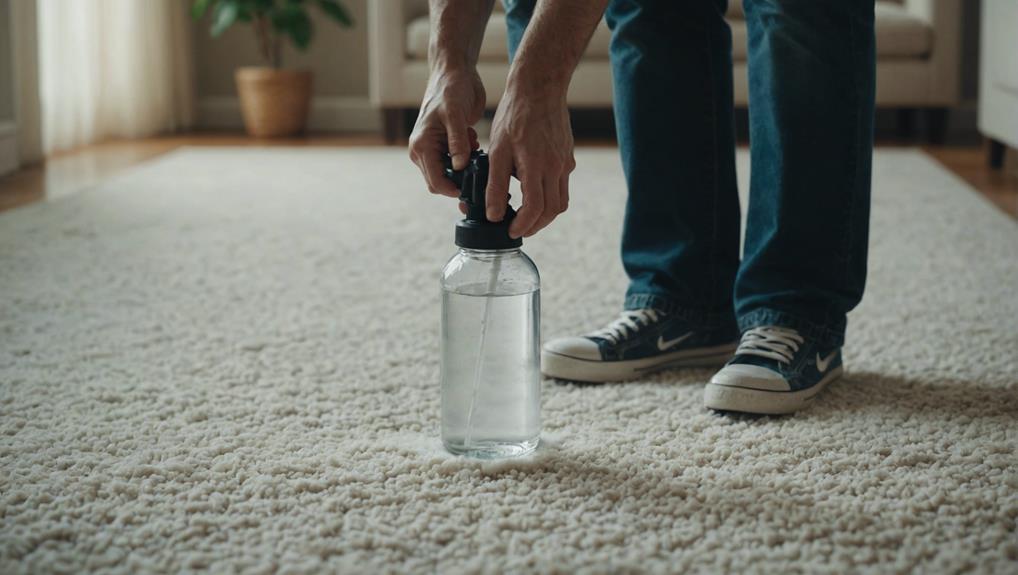
Using vinegar for carpet cleaning offers numerous benefits. Its natural and eco-friendly properties make it a safe and effective solution for removing odors and disinfecting carpets.
The acidity of vinegar aids in breaking down stains and dirt, helping restore your carpet's appearance while being affordable and easy to find.
Vinegar's Cleaning Power
Harnessing the natural cleaning power of vinegar can transform the way you tackle carpet stains and odors. Here's why vinegar is a game-changer for carpet cleaning:
- Vinegar is a natural and versatile solution for removing stains and odors from carpets.
- The acidity in vinegar effectively breaks down dirt and grime, making it a potent cleaner for carpets.
- Mixing vinegar with water creates an eco-friendly and non-toxic cleaning solution that's both gentle and efficient.
- Vinegar not only helps disinfect carpets but also neutralizes pet odors, leaving your carpets fresh and clean.
Eco-Friendly Solution
Embrace the eco-friendly benefits of using white vinegar for carpet cleaning to enjoy a natural and effective cleaning solution. White vinegar serves as a natural disinfectant, effectively killing bacteria and germs on carpets without the need for harmful chemicals. Its acidic properties break down stains and odors, making it a cost-effective and environmentally friendly option for deep cleaning various carpet types.
By using a solution of vinegar and water, you can securely clean most carpets while also aiding in maintaining indoor air quality by eliminating allergens. This eco-friendly approach not only benefits the environment but also guarantees a thorough and safe carpet cleaning process for your home.
Say goodbye to harsh chemicals and embrace the power of vinegar for a greener and more sustainable way to keep your carpets clean and fresh.
Utilizing Baking Soda and Salt
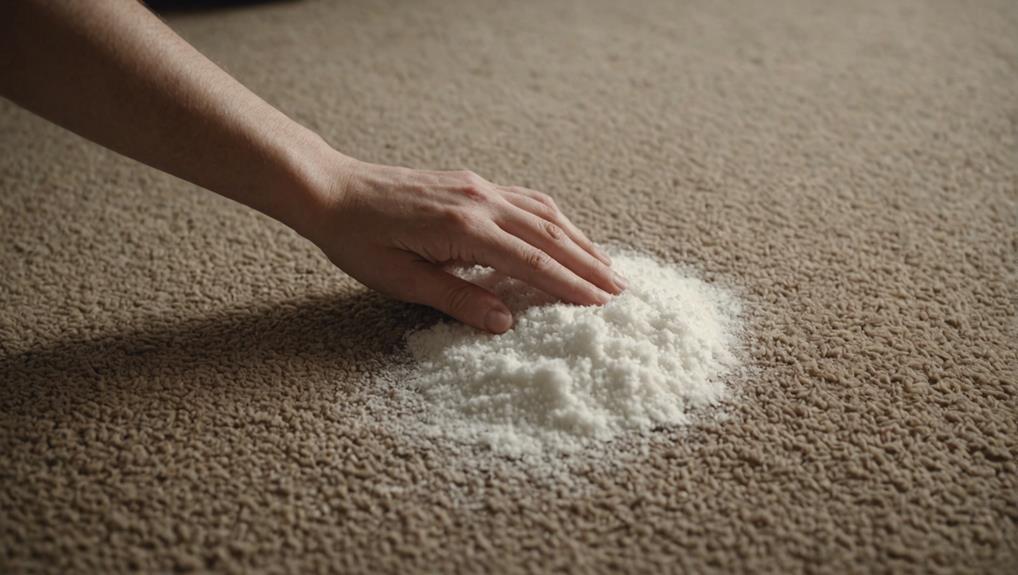
You can achieve effective carpet cleaning by combining equal parts of baking soda and salt. This DIY carpet cleaning solution is a natural method that helps absorb moisture, deodorize carpets, and tackle tough stains. Here's how to utilize baking soda and salt for a fresher-looking carpet:
- Mix equal parts of baking soda and salt.
- Sprinkle the mixture on the carpet.
- Dampen the area with water.
- Scrub the solution into the carpet to remove dirt and odors effectively.
After scrubbing, wipe away the dirt with towels and allow the carpet to air-dry completely. Once dry, vacuum up any remaining baking soda.
Using baking soda and salt is a cost-effective and eco-friendly way to deep clean your carpets without harsh chemicals. This method not only cleans but also leaves your carpets smelling fresh and looking revitalized.
Step-by-Step Guide to Steam Cleaning
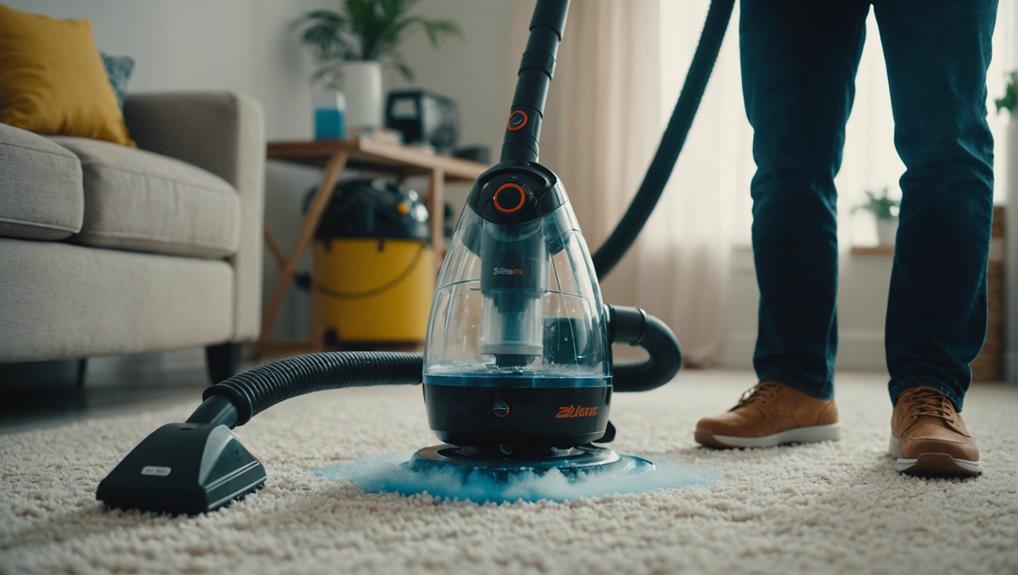
To effectively steam clean your carpet, begin by preparing the necessary equipment and space for the cleaning process. Steam cleaning, also known as hot water extraction, is a method that provides a deep clean by reaching into the carpet fibers. This process helps extract embedded dirt and grime, improving indoor air quality by removing allergens and bacteria. Professional services often use specialized equipment to guarantee a thorough clean that can extend the lifespan of your carpet.
When steam cleaning your carpet, make sure to follow the manufacturer's instructions for the cleaning solution and machine. Begin by vacuuming the carpet to remove any surface debris. Then, fill the steam cleaner with the recommended amount of water and detergent.
Slowly pass the machine over the carpet, making sure to cover the entire surface area. Allow the carpet to dry completely before walking on it again.
Regular steam cleaning, at least once a year, can help maintain your carpet's appearance and contribute to a healthier indoor environment.
Maintaining Clean Carpets Longer
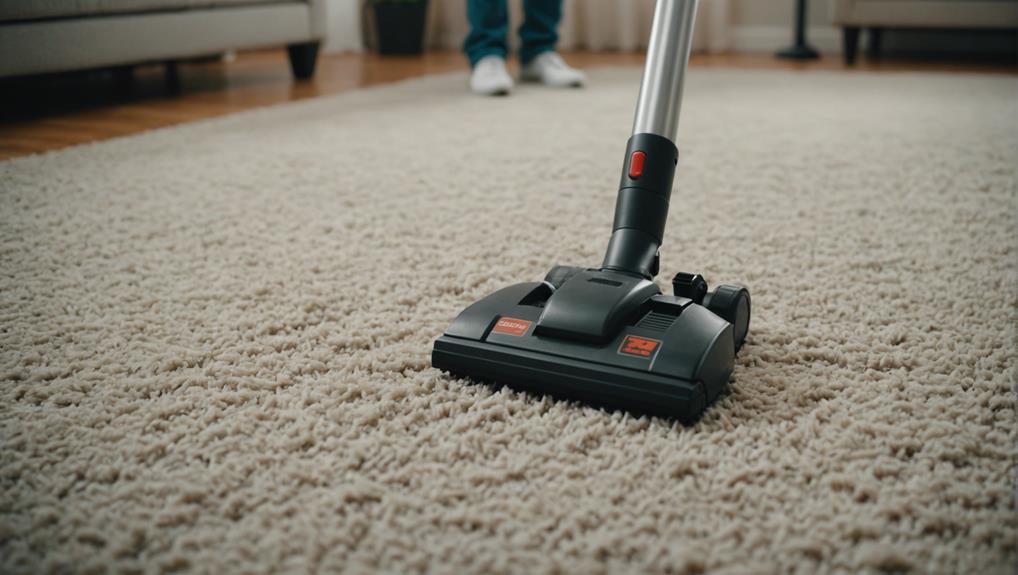
Implementing preventive measures is crucial to extending the cleanliness and lifespan of your carpets. To Keep Carpet Clean longer, consider the following tips:
- Use walk-off mats: Place these at entrances to reduce dirt tracked onto carpets by up to 80%.
- Vacuum high-traffic areas: Aim to do this twice a week to prevent dirt buildup and extend the life of your carpet.
- Rotate furniture: Periodically moving furniture around can prevent wear patterns and evenly distribute foot traffic.
- Promptly treat spills: Engage in spot cleaning as soon as spills occur to prevent them from setting and becoming harder to remove.
Keeping your carpets clean involves a combination of deep cleaning methods like steam cleaning and daily maintenance. By incorporating these preventive measures, you can make sure that your carpets stay looking their best for longer periods, reducing the need for frequent deep cleaning sessions.
Proper Vacuuming Techniques
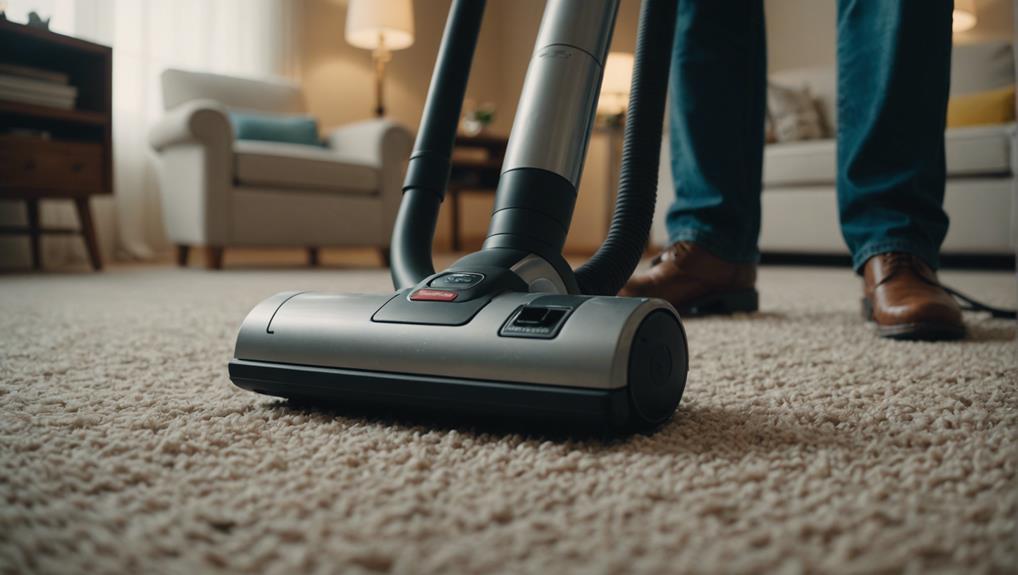
For effective carpet maintenance, mastering proper vacuuming techniques is essential. When vacuuming, make sure to cover the carpet in overlapping rows to prevent dirt buildup, especially in high-traffic areas.
Adjust the vacuum height setting according to the carpet pile height for best suction and effective debris removal. Utilize attachments like crevice tools and upholstery brushes to clean edges, corners, and furniture thoroughly.
Remember to empty or replace vacuum bags regularly to maintain strong suction power and prevent dust and allergen buildup. Consider investing in a vacuum cleaner with HEPA filters to trap small particles and improve indoor air quality during carpet cleaning.
Professional Carpet Cleaning Tips

Consider scheduling professional carpet cleaning every 12 to 18 months to maintain your carpet's appearance and durability.
When hiring a professional carpet cleaner, keep in mind the following tips:
- Deep Clean: Professional cleaners utilize high-powered equipment to remove deep-seated dirt effectively.
- Stain Remover: They've access to specialized stain removers to tackle tough stains that regular cleaning may not fully eliminate.
- Steam Cleaner: Using steam cleaners, professionals can provide a thorough and sanitizing clean for your carpets.
- Carpet Cleaning Method: Professionals follow industry standards set by the Carpet and Rug Institute, ensuring proper carpet maintenance and cleaning techniques are used.
Essential Tools and Materials for Cleaning
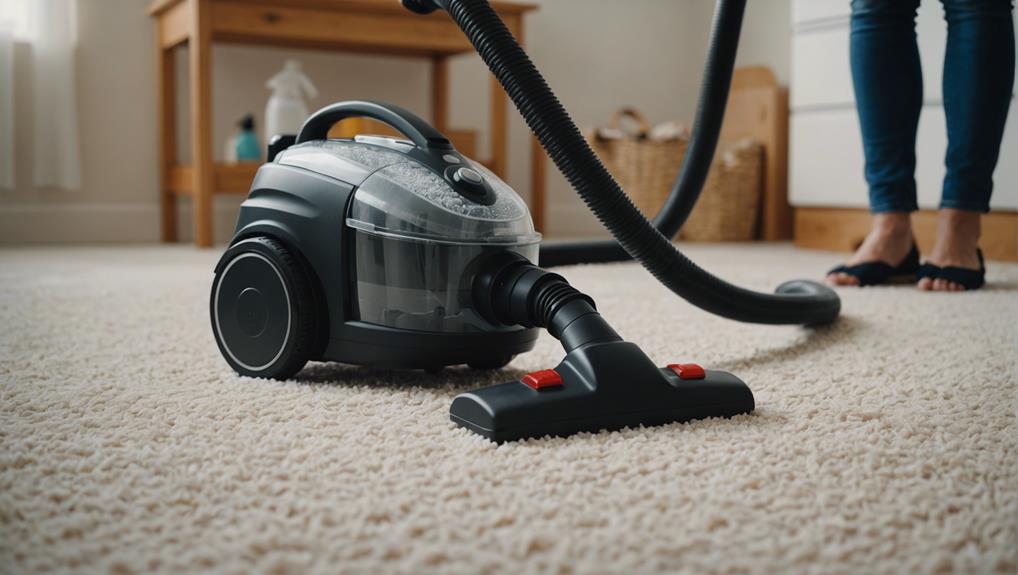
To effectively clean your carpet, make sure you have essential tools and materials readily available. Having a good vacuum cleaner, DIY steam-cleaning machine, sponges, and spot treating cleaners is important. Additionally, using indoor and outdoor floor mats can help prevent dirt from reaching your carpets, keeping them cleaner for longer. When accidents happen, having paper towels on hand for blotting spills and stains is essential. Don't forget about maintaining your vacuum's efficiency by regularly changing vacuum filters. Finally, invest in quality carpet-cleaning soap for deep cleaning and preserving your carpets' quality. Below is a table summarizing the essential tools and materials for effective carpet cleaning:
| Tools and Materials | Description | Importance |
|---|---|---|
| Vacuum Cleaner | Essential for regular carpet maintenance | High |
| DIY Steam-Cleaning Machine | Ideal for deep cleaning | Medium |
| Sponges | Great for spot cleaning and scrubbing | Medium |
| Spot Treating Cleaners | Effective for treating specific stains | High |
Frequently Asked Questions
What Is the Most Effective Way to Clean Carpets?
To clean your carpets effectively, vacuum regularly to remove surface dirt. Deep clean every 12-18 months for maintenance. Promptly spot clean stains with proper solutions. Hire pros annually for thorough cleaning. Consistent care and techniques maintain cleanliness and freshness.
What Is the Proper Way to Use a Carpet Cleaner?
To use a carpet cleaner properly, dilute the solution as directed, test on a small spot, move slowly, empty the tank often, and let the carpet dry fully. This will help avoid damage, lift dirt effectively, and prevent mold growth.
What Is the Most Important Step in Keeping a Carpet Clean?
To keep your carpet clean, the most crucial step is vacuuming regularly. By removing dirt and debris weekly, you prevent damage and maintain its appearance. Don't overlook proper techniques and settings for effective cleaning.
What Is the Best First Step When Spot Cleaning a Carpet?
The best first step when spot cleaning a carpet is to immediately blot liquid spills with paper towels to prevent staining. Use a carpet stain remover for liquids and lift solids like mud with a credit card before cleaning.
What Are the Best Techniques for Cleaning Carpets?
When it comes to keeping your carpets clean, expert carpet cleaning methods are crucial. Regular vacuuming, spot treating spills, and using professional steam cleaning services are some of the best techniques for maintaining the cleanliness of your carpets. Additionally, rotating furniture and using protective pads can help prevent wear and tear.
Conclusion
To sum up, regularly cleaning your carpet using the right techniques can greatly extend its lifespan and keep your home looking fresh and clean.
By utilizing effective stain removal methods, natural cleaning agents like vinegar and baking soda, and proper steam cleaning practices, you can maintain your carpets in top condition for years to come.
So, why wait? Start implementing these tips today for a cleaner and healthier living environment.
